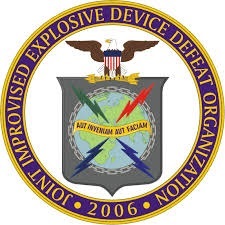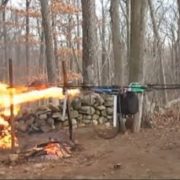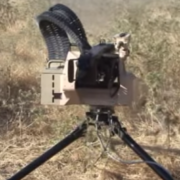The article below originally appeared in the Counter-IED Report.
 Concerns are being expressed that all the counter-IED knowledge that’s been learned during the protracted wars against terrorism in Iraq and Afghanistan will be lost if the Joint Improvised Explosive Device Defeat Organization (JIEDDO) is slashed or abolished under the proposed plan to scale back the organization.
Concerns are being expressed that all the counter-IED knowledge that’s been learned during the protracted wars against terrorism in Iraq and Afghanistan will be lost if the Joint Improvised Explosive Device Defeat Organization (JIEDDO) is slashed or abolished under the proposed plan to scale back the organization.
The impact of losing this critical know-how was the focus of Patrick McGlynn and Godfrey Garner’s article,“Preserving Counter-IED Institutional Memory,” in the Dec.-Jan. issue of Homeland Security Today.
McGlynn and Garner pointed out that “Some of the most imperative technical training and knowledge that emerged from the conflicts in Iraq and Afghanistan were defense tactics against the IED threat.”
And, they presciently warned, “While IEDs were one of the biggest threats to troops during the conflicts, the biggest threat today is losing the lessons we learned. If we don’t protect institutional counter-IED knowledge, it will be one of the most significant intelligence losses in our nation’s history.”
In 2012, the Department of Defense (DoD) released its 2012-2016 JIEDDO Counter-IED Strategic Plan, which was touted as “intended to provide the framework to coordinate the Defense Department’s counter-IED efforts.”
The Pentagon’s announcement said “The strategy, looking at the next five years, attempts to capture the lessons learned during the previous ten years since operations began in Afghanistan and Iraq,” and outlined five principal goals: rapidly identify, validate and prioritize immediate and future counter-IED requirements; provide operations and intelligence fusion; rapidly seek, develop and acquire counter-IED solutions; lead DoD counter-IED training; and build a joint, interagency, intergovernmental and international community of action.
This week, however, the Army News Service reported that JIEDDO Director Army Lt. Gen. John D. Johnson said he’d received guidance from then-Deputy Defense Secretary Ashton Carter to “scale JIEDDO down” and to draw up plans for what an “enduring” JIEDDO might look like in the future.
The organization’s “size is expected to shrink significantly, according to its director,” the Army News Service said.
Massive cuts, is more like it.
The organization is scheduled to be cut to 1,000 personnel from 3,000 by the end of this fiscal year, Johnson said. But still further guidance from the deputy secretary of defense could later bring JIEDDO’s numbers down to as few as 400, he said.
Johnson said he will have to spell out to the deputy secretary just what could be done with only 400 personnel — and what the risks are that will be associated with that large of a drawdown for such an important organization.
“There are certain parts of an organization like this that if you reduce it beyond a point, it could take six months, a year, even longer, to re-establish it,” Johnson said. “And in that time period, our soldiers and Marines in the field are suffering from the effects of IEDs, and it ends up costing us more to try to fix the problem without necessarily having the sophistication of understanding the entire system of systems.”
And some parts of JIEDDO just can’t be easily be scaled back up, either, like the intelligence integration functions of JIEDDO that Johnson said he’s working to protect.
This is the counter-IED institutional knowledge base McGlynn and Garner wrote they fear could be decimated if JIEDDO is whittled away to virtually nothing.
“My concern is, right now,” Johnson said, is “we have a fairly persistent look at the organizations that most commonly use IEDs.” But, he cautioned, “If we were to take our eyes off, what are the chances that there would be an adaptation or permutation in the way they use IEDs that we didn’t anticipate, and how long for us to catch up?”
Indeed. “There is great value in sharing information among the various agencies in our government [like US law enforcement] to make sure we don’t miss out on experiences we’ve had abroad and … how we have benefited from that knowledge here,” Johnson stressed. “We collaborate with the other agencies very closely.”
In the wake of the jihadi-inspired IED bombings at the Boston Marathon, Johnson said “the discussions … were really a comparison of experiences to see if there were ways that we could learn from what happened there, and they could learn from anything that we did. One of the most important things we’ve done is in the investment of the Terrorist Explosive Device Analytical Center [TEDAC] that the FBI has.”
JIEDDO has invested in TEDAC because “we needed the highest level of forensic capabilities to take a look at these IEDs and tell us who was responsible for them and also to help us track if they were flowing from one country to the next,” Johnson pointed out.
Johnson said the biometric and forensic capabilities that have and continue to be learned on the battlefields of the Global War on Terror has helped to identify who makes and uses IEDs.
This intelligence has proved useful on the US’s Southwest border, where biometric information collected from foreign battlefields identified at least one suspected terrorist trying to enter the country, Homeland Security Today previously reported.
“The inevitable next fight is somewhere in our future,” Johnson said, and “We must be able to rapidly posture for that fight. We must continue to lean forward and stay abreast of how our enemies are using IEDs and what new tactics and technologies they are employing. This will allow us to develop the capabilities to defeat the IED, the tactics to attack enemy networks and train our forces so they are prepared for the IED environments we will face in the future.”
And it will help to identify terrorists who might try to enter the US, or, if more IEDs are detonated on US soil, help to identify the terrorists responsible.









